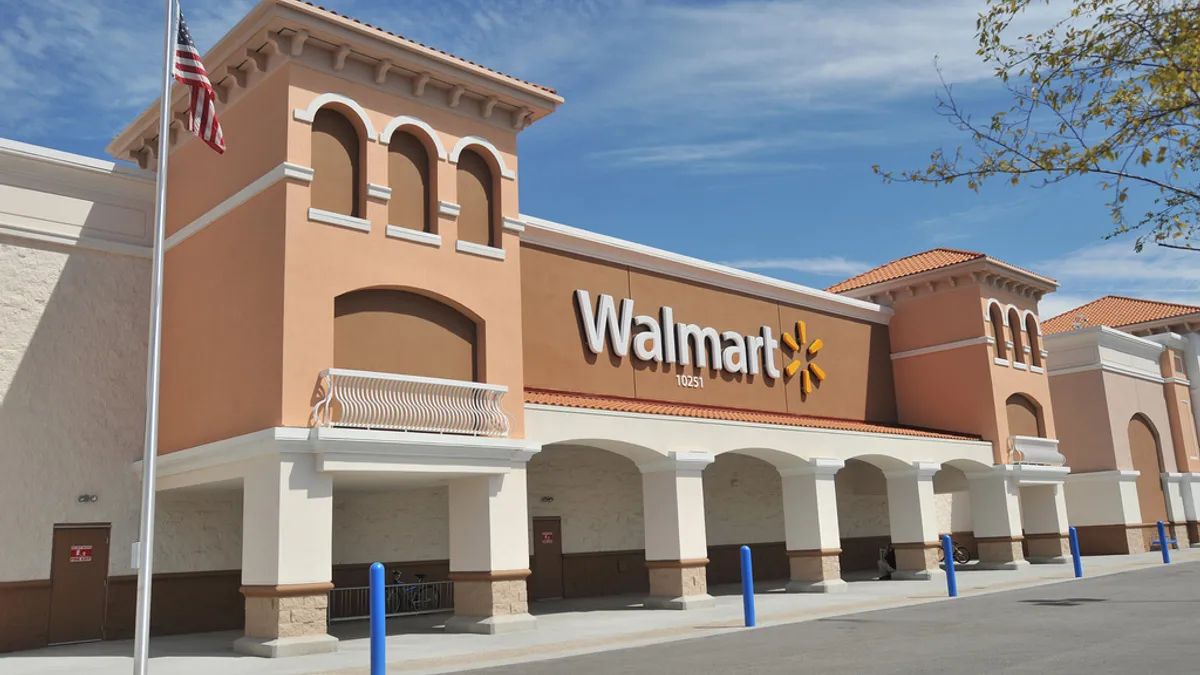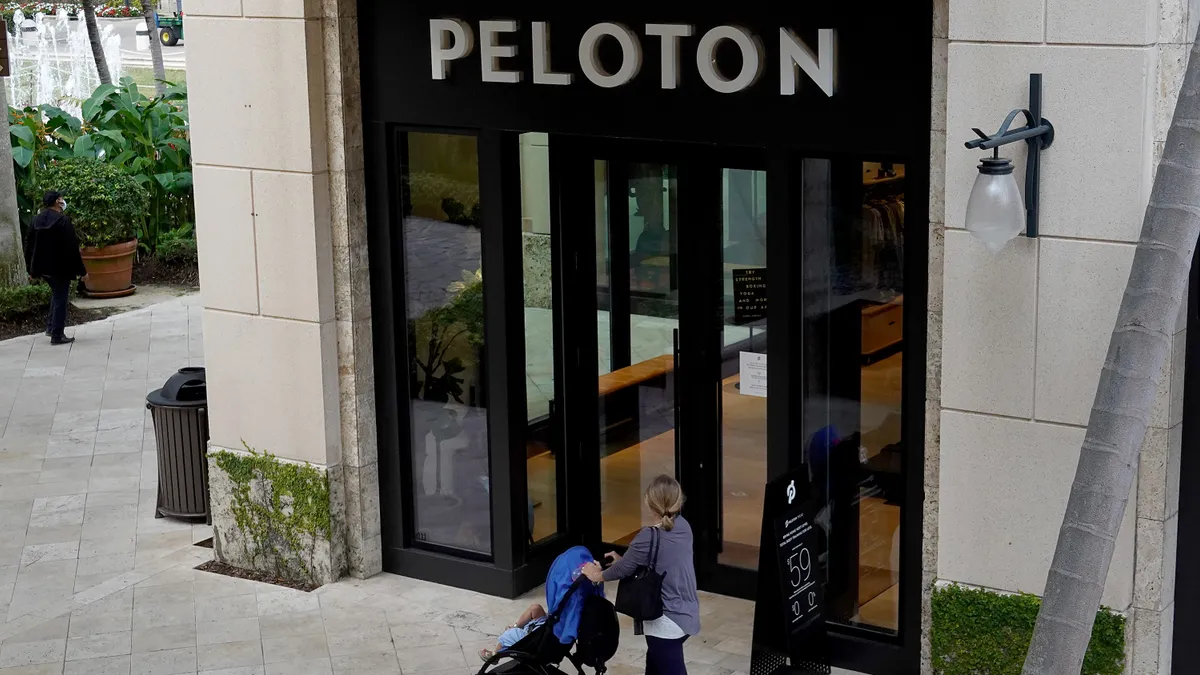Walmart was rewarded handsomely by Wall Street last week after posting a stratospheric 50% increase in third-quarter e-commerce sales. Investors — partial to any sign that a legacy retailer is flexing muscles online in the shadow of Amazon’s massive disruption machine — sent shares up more than 10% after the report, its best showing in nearly a decade.
It was a hearty endorsement of Walmart’s newfound willingness to play on Amazon’s turf, evident in its purchase last year of Jet.com and the spree of acquisitions that have followed.
But Walmart’s latest partnership isn't with a millennial-focused online apparel brand like Bonobos or Modcloth, or even a defunct but attractive url like Shoes.com, all of which it spent money on earlier this year. Rather, the world’s largest brick-and-mortar retailer announced a partnership with another brick-and-mortar stalwart, in one of retail’s most longstanding segments — department stores. Next spring, none other than Lord & Taylor, America’s oldest luxury department store (now owned by Canada’s Hudson’s Bay Co.), will open a flagship storefront on Walmart.com.
Denise Incandela, head of fashion for Walmart U.S. e-commerce, said the retailer is "excited" about it. "Our goal is to create a premium fashion destination on Walmart.com," she said in a statement. "We see customers on our site searching for higher-end items, and we are expanding our business online to focus on adding specialized and premium shopping experiences, starting with fashion."
Several observers see it as a win-win. For Walmart, it's a convergence of apparel brands now selling through Lord & Taylor and an answer to Amazon’s steadily building fashion sales. For Lord & Taylor, the program could produce a surge of online traffic from Walmart’s massive customer base.
"With Lord & Taylor's weaker digital presence, they stand to benefit much from Walmart's strategy and economies of scale," according to Sean Maharaj, director in the retail practice of global consultancy AArete. "For traditional brick and mortar destination outlets like Lord & Taylor, they'll need to diversify quickly in order to remain relevant and survive. Whereas Walmart needs to leverage more partnerships like this to expand its traditional value-based consumer model into other areas that compete with the likes of Amazon. Finally, middle America is getting pinched more and more, and Walmart needs another horse in the race."
But some observers aren't sure it's a good fit. "What we find unexpected is the implication that Walmart's online shoppers are actively searching for high-end premium brands, so much so that leveraging Lord & Taylor in their marketplace is a customer success imperative," Tushar Patel, chief marketing officer of omnichannel solutions platform Kibo, told Retail Dive in an email. "Walmart built its empire by being the self-proclaimed low-price leader, and it's interesting to watch as it tries to parlay that branding into luxury. "Walmart and Lord & Taylor claim to have the pulse on customer behavior and desires, which seems incongruous with what we've seen in the market."
Others put it another way.
"Crazy. Loony," Howard Davidowitz, chairman of New York City-based retail consulting and investment banking firm Davidowitz & Associates Inc., told Retail Dive. "Madness."
The Marketplace
There are reasons for the move, on paper at least. For Walmart, it’s not just about e-commerce, but also its marketplace, an e-commerce model that has gained in importance in recent years. Last year, shoppers did half of their online spending through marketplaces and that could rise to two-thirds in five years, according to a July Forrester Research report. The usual suspects are running the space: 75% of marketplace buyers shopped at the marketplaces run by Amazon, Alibaba (Tmall), JD.com and eBay, according to the report. But notably, not at Walmart.
Walmart's marketplace was launched in 2009, but was largely operated as an afterthought. That changed in recent months as Walmart made an effort to expand its online assortment, which has been dwarfed by Amazon’s. And according to research from eMarketer, sellers have increasingly sought to diversity beyond Amazon (where half the goods sold go through the marketplace), helping to fuel Walmart's marketplace momentum.
Lord & Taylor — a name-brand department store that sells many other known brands — could further boost the site's profile. "What's great about this partnership is how Walmart is positioning it as a online mall where customers would come and shop for specific brands that Walmart has vetted," Matt Sargent, senior vice president of retail at Frank N. Magid Associates, told Retail Dive. "If you compare this to Amazon's Marketplace, where there are literally thousands of sellers, Walmart's approach might appeal to buyers would want to feel that a given seller has been approved in some way."
Lord & Taylor, as a retailer in a declining retail segment without much of an online presence, benefits from Walmart’s massive scale and reach, said Peter Killian, principal of boutique consulting firm The Cambridge Group. In her statement on the deal, Lord & Taylor President Liz Rodbell said as much.
"As retail continues to change, this flagship store creates enormous growth opportunities for Lord & Taylor and our brand partners," she said. "Our customers trust us to deliver high-quality fashion apparel and accessories, and we will soon be able to extend the reach of that offering to new customers through this flagship store. Walmart.com is a shopping destination that reaches a wide base of customers looking for premium fashion brands. They are a great company for us to work with as we continue to grow our digital presence."
But there are pitfalls, Killian warns: Brands selling through Lord & Taylor may not like the association with Walmart. "The real risk is brands fleeing Lord & Taylor stores, or refusing to sell through Walmart's site," he told Retail Dive in an email.
The merchandise
Walmart’s acquisition tear of the last year hasn’t just been about jump-starting e-commerce sales — it’s also intended to upgrade its apparel play. Shortly after the holidays last year, Walmart bought online shoe retailer Shoebuy, in a challenge to Amazon's Zappos, for $70 million. In February, the company bought online outdoor apparel retailer Moosejaw for $51 million in cash, in March announced the acquisition of vintage-inspired online women’s apparel Modcloth and in June bought menswear site Bonobos for $310 million.
"Walmart’s shoppers have little in common with Lord and Taylor’s shoppers. Lord and Taylor shoppers are unlikely to trust the Walmart brand, and the department store industry is a dying business in any case."

Nick Egelanian
President, SiteWorks International
This is not the first time the retail giant has attempted to grow apparel. Eight years ago Walmart launched "Project Impact," an effort to improve the quality of apparel and home furnishings, clean up stores and present friendlier customer service. But the effort was widely seen as a disaster. Before that, in 2005, Walmart placed ads in Vogue magazine and sponsored a New York City fashion show to highlight new, higher-priced apparel lines. The result was another disaster, and another retreat. In turning to Lord & Taylor, Walmart may have made its latest fashion mistake, according to Davidowitz.
"Walmart has spent 50 years trying to improve their apparel, right? They haven't done it," he said. "I wouldn’t call Lord & Taylor a fashion leader. If I wanted to learn about fashion, I wouldn't go to Lord & Taylor. Every time there’s an obituary, Lord & Taylor loses a customer! What I would have done is, when The Limited liquidated, I would have bought their intellectual property. That would have been better for them, and cheaper."
Still, apparel sales are moving online — and to Amazon. Apparel and footwear sales at Amazon U.S. totaled $13 billion in 2016, up $9 billion from five years ago, according to Euromonitor.
"The extensive sales channel provided by Amazon’s e-commerce platform, coupled with the company’s data analytics that can help predict and adjust to ever-changing consumer demands, almost ensures that Amazon’s private labels have a real shot at eroding the market share of established players," Deborah Weinswig, managing director, retail think tank Fung Global Retail & Technology, told Retail Dive in an email. "Walmart, leading the pack with over $23 billion in apparel sales in 2017, understands the threat presented by Amazon, and has decided to take action to stem the continuous loss of market share."
"I get the fact that Walmart is trying to keep up with Amazon on the PR front, but this was a boo-boo. It just feels brand wrong, for both parties."

Lee Peterson
EVO, Brand Strategy, WD Partners
Other experts agree, but many, like Davidowitz, question the choice of Lord & Taylor. "It is understandable why Walmart would want to build its apparel sales on the internet, as almost 30% of apparel sales are occurring online, and Walmart is not currently participating," retail analyst Nick Egelanian, president of retail development consultants SiteWorks International, told Retail Dive in an email, adding that an alliance with an off-price seller like Ross or T.J. Maxx might make more sense.
"Walmart’s shoppers have little in common with Lord and Taylor’s shoppers," Egelanian said. "Lord and Taylor shoppers are unlikely to trust [the] Walmart brand, and the department store industry is a dying business in any case. Keep in mind that total department store industry sales this year will likely not exceed $70 billion while Walmart alone will do over $500 billion in worldwide sales this year."
The customers
Lord & Taylor is generally thought of as an upscale department store, though much of that branding is a bit tarnished with age. "I'd love to see a poll done of Walmart users and how many of them have ever been in an Lord & Taylor," Lee Peterson, executive vice president of brand strategy and design at design firm WD Partners, told Retail Dive. "I get the fact that Walmart is trying to keep up with Amazon on the PR front, but this was a boo-boo. It just feels brand wrong, for both parties."
Maybe that's the point. The partnership brings "luxury equity" to Walmart's more mainstream customer base, in contrast to Modcloth and Bonobos, which Walmart is promoting to its younger, wealthier Jet.com customers, according to The Cambridge Group's Killian. "It reflects that Walmart's shopper base, especially online, is no longer just a deep-value customer," he said. "For this new customer, Walmart's brand gets a direct style halo. Unlike Bonobos and ModCloth where there is no brand linkage to Walmart (yet), the brand association here is explicit, raising Walmart's luxury profile."
It also demonstrates that Walmart is now looking to deepen its offer and experience in certain categories, including apparel. "This is one of the reasons it has struck deals with partners like Lord & Taylor in fashion and is building relationships with premium brands like KitchenAid and Bose," according to GlobalData Retail Managing Director Neil Saunders. "Walmart's longer-term aim is clear — it wants to become the go-to online destination for both every day and specialty items. The push into higher-end products should also help to bolster online margins."
That could be critical, considering that Walmart's burgeoning e-commerce sales are impacting its bottom line, a rare problem for the globe's most efficient mover of goods. Gross profit margin in the third quarter declined 29 basis points, due mostly to price cuts in certain markets and "the mix effects of our growing e-commerce business," plus an impact from hurricanes, according to Walmart CFO Brett Biggs. That reality is behind its recent move to raise some of its online prices. "It simply costs less to sell some items in stores," a Walmart spokesperson told Retail Dive in an email.
The Muddy Middle
To some, the Lord & Taylor-Walmart alliance is just the latest sign of America's declining middle class. The wage gap appears to be re-emerging after showing signs of narrowing, according to a September note from financial services firm Cowen & Co. Retailers that are accessible to lower-income groups and have strong omnichannel plays and differentiated merchandise to compete with Amazon, or those that cater to higher-income consumers, are in the best position to handle changes in these macroeconomic and microeconomic trends, Cowen said.
"If you’re Walmart, your choice has become binary: If you want to grow your business you either extend further down, which is treacherous and low profit at best, or you move upmarket, which is a much better choice, if they can pull it off," Doug Stephens, author of "Reengineering Retail: The Future of Selling in a Post-Digital World," told Business Insider.
"Walmart's longer-term aim is clear — it wants to become the go-to online destination for both every day and specialty items. The push into higher-end products should also help to bolster online margins."

Neil Saunders
Retail Managing Director, GlobalData
Walmart appears to be trying to have it both ways. That's a tricky strategy and there's no guarantee that, when it comes to the marriage of Lord & Taylor and Walmart, it'll all work out. "On the surface, it doesn't appear to be a natural partnership," Sam Cinquegrani, CEO of digital marketing and services firm ObjectWave, told Retail Dive. "The brands are very different and their customer base seems different as well. It's a smart move on both parties from the aspect of leveraging each others’ strengths. However, I'm not sure their respective customers will embrace it."






















